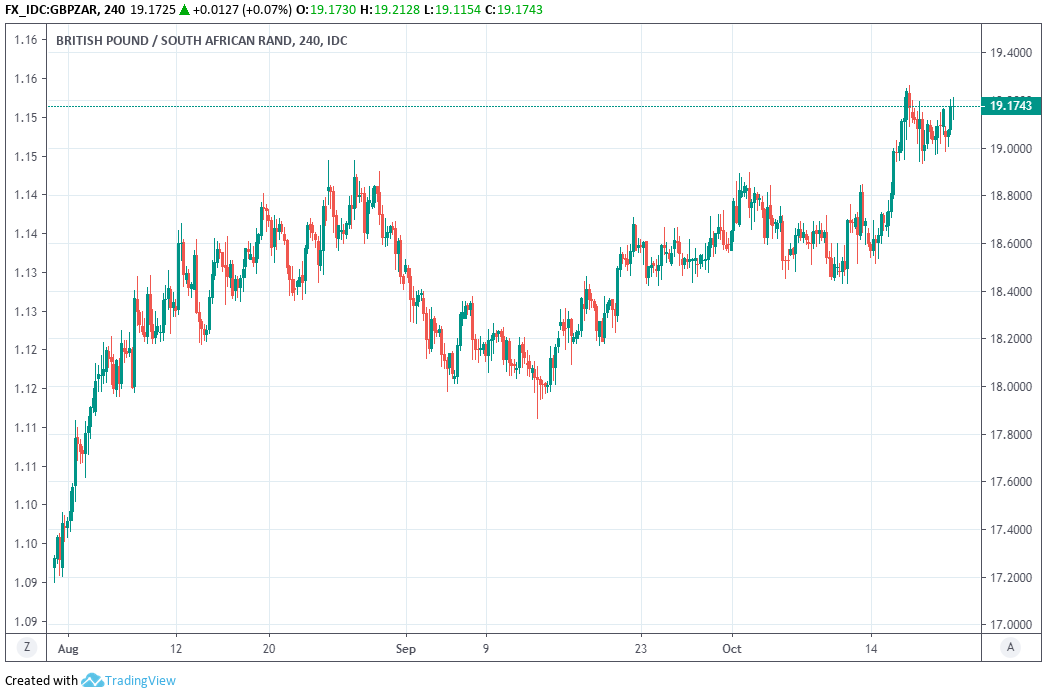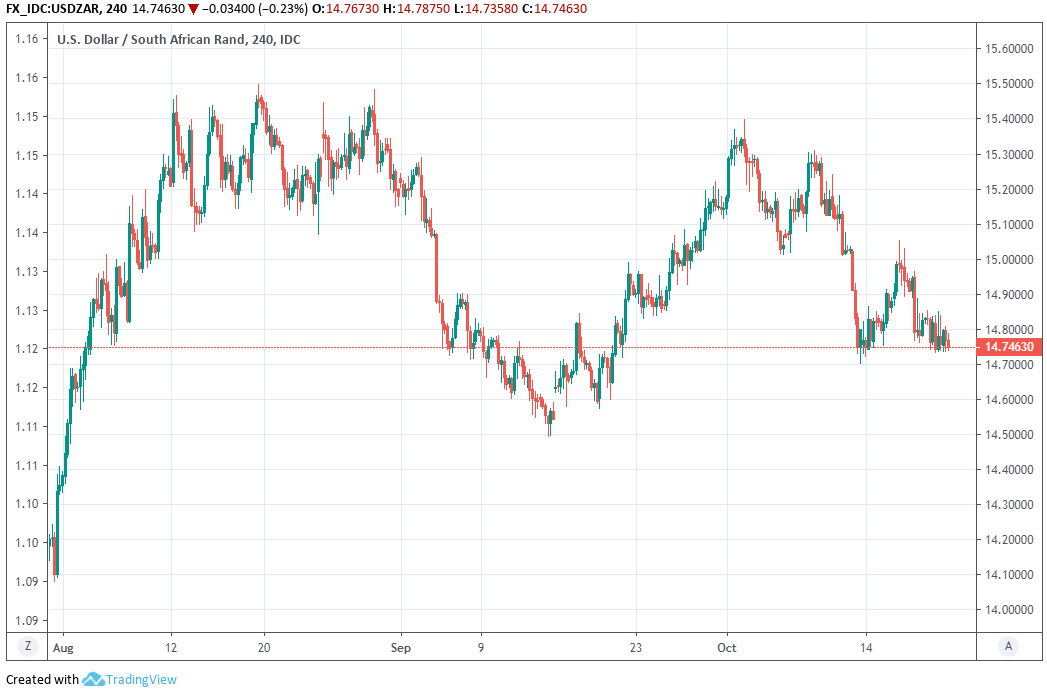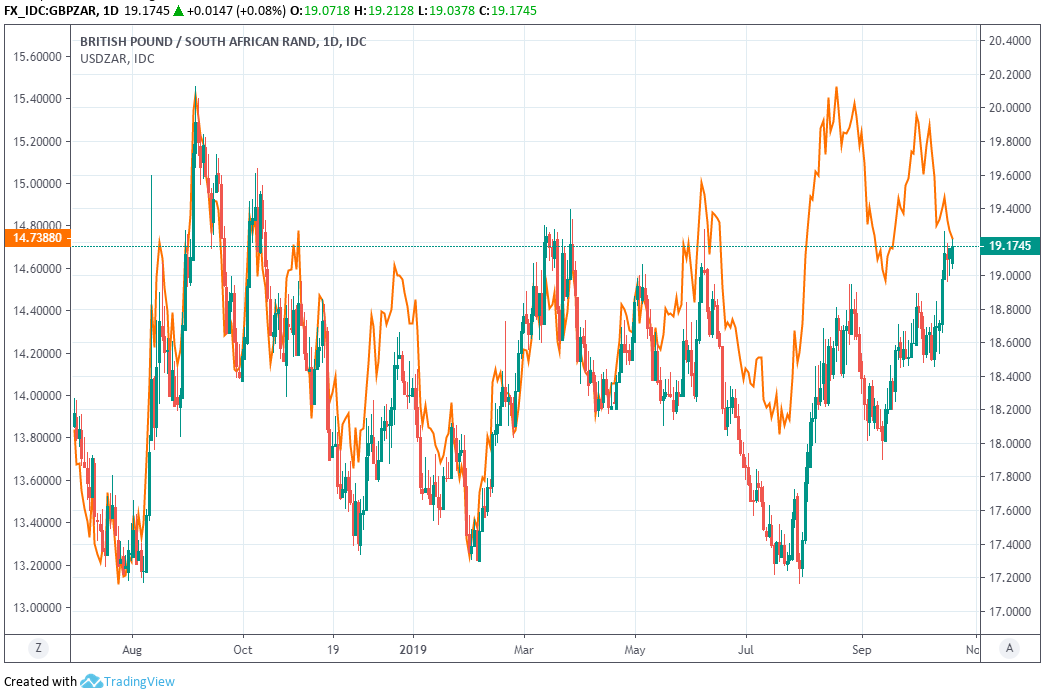South African Rand Rises amid Global Risk Rally as Offshore Factors Dominate
- Written by: James Skinner
-

Image © Government of South Africa
- ZAR creeps higher as USD retreats amid global risk rally.
- Ebbing of 'no deal' Brexit risk sees risk appetites recover.
- Boosts European currencies, sees USD remain in decline.
- But October 29 budget, Eskom plan and Moody's still key.
The Rand entered the new week on its front foot Monday amid a global rally in 'risk assets' connected to the ebbing of 'no deal' Brexit risk, which could offer more support in the days ahead although the outlook for the South African currency is still hinged in substantial part on domestic factors.
Risk assets including emerging market currencies were on the rise Monday and safe-havens firmly in retreat amid speculation that a 'no deal' Brexit may have become a lot less likely at the weekend, following the passing of a 'rebel' amendment in the House of Commons.
Members of the UK parliament agreed that Prime Minister Boris Johnson should request from the EU a third delay to Brexit, and one that lasts as long as is necessary to secure a withdrawal agreement that prevents a 'no deal' exit. This was after Johnson emerged from the European Council chamber in Brussels proclaiming a deal that had put him on course to test the parliamentary waters with it.
However, Saturday's voting on the agreement itself was scuppered by opposition MPs who, aided by the apparently partisan and anti-Brexit Speaker of the House of Commons, hijacked the parliamentary agenda and imposed themselves upon the government. The amendment leaves in its wake a series of unanswered questions about the future of the current UK constitutional order but, and crucially for the financial markets, makes a 'no deal' Brexit less likely.
"[Johnson] remains resistant to a further delay and will likely re-approach parliament today to deliver on his Brexit promise of leaving the EU by month-end," says Shireen Darmalingham, an economist at Standard Bank. "UK trade partners have been preparing for Brexit. Once SA’s eighth-largest export market in 2017, the UK was fourth-largest in 2018, with exports largely precious metals, motor vehicles and agricultural products."

Above: Pound-to-Rand rate shown at 4-hour intervals.
Johnson has since complied with the 'Benn Act' demand that he request a third Brexit delay because the October 19 deadline lapsed without parliament backing a withdrawal agreement. The EU is yet to give its formal response to the request for a delay, which may or may not have been sabotaged by Johnson omitting his signature from the letter requesting one.
The Prime Minister is now expected to seek a Commons ballot on his EU exit proposals although, after the weekend's shenanigans in Westminster, markets are less concerned about a 'no deal' Brexit following on from any possible rejection of agreement. Many say a 'no deal' Brexit would badly wound Sterling and that the Euro wouldn't be left unscathed either, which means such an outcome would likely lift the Dollar and hurt the Rand.
Readers can catch the latest on the Brexit saga here.
"The increasing likelihood that a Brexit deal will be passed through the UK parliament has boosted the appeal of European currencies at the expense of the US dollar in the near-term. At the same time, the US dollar has been undermined by dovish comments from Fed officials," says Fritz Louw, a currency analyst at MUFG.
South Africa's Rand, much like other emerging market currencies, has a strong negative correlation with the Dollar. A rising Dollar makes foreign currency debt more expensive to service and commodity imports more expensive to buy, while a weaker one does the opposite. A stronger Dollar can also upset the global economy, leading to increased demand for safe assets, including the greenback, and perpetuating a viscious cylce.

Above: USD/ZAR rate shown at 4-hour intervals.
The prospect of an agreement being reached and enabling the UK to avoid a disorderly Brexit is boosting European currencies, which account for more than 60% of the Dollar index, and placing the greenback under pressure. That could potentially continue for a while yet unless something upsets the Brexit apple cart, or the Federal Reserve (Fed) does something to revive the Dollar.
"The desk still believes there is a little more ZAR strength to come before the next spike in USDZAR," says Georgina Moore, a short-term interest rates trader at UBS. "Keep an eye on South African CPI data due on Wednesday. It is expected to print at +4.3% y/y, which is marginally below the midpoint of the central bank's target range."
The Fed interest rate decision on October 30 is the next milestone for the U.S. Dollar and investors are currently betting the bank is almost certain to cut its interest rate for what will be a third time this year, although they're also looking for a series of additional cuts next year. Whether or not the Fed does cut, as well as what it says about the outlook for borrowing costs, will also be key in determining the direction of the Dollar and Rand over the coming months.
South Africa's budget statement, due on October 29, will also be important in determining market appetite for the Rand because details and forecasts revealed within the budget will feed directly into market expectations for the credit rating. Moody's, the last major rating agency to still have South Africa as an 'investment grade' prospect, is due to announce its latest decision on November 01 although markets currently expect it to only downgrade the outlook on the rating from stable to negative.

Above: Pound-to-Rand rate at daily intervals alongside USD/ZAR rate (orange line, left axis).
Any loss of the 'investment grade' rating would see investors, particularly those benchmarking to the Citi World Government Bond index, forced into selling their bonds. That would likely mean large outflows of capital from South Africa.
"Eskom is aiming for no power cuts this week despite its constrained system. Several units have been returned to the grid after planned and unplanned maintenance as well as a healthy water level at Eskom’s pumped storage schemes. We look to the Moody’s review of SA scheduled for release on 1 November on whether it will preserve SA’s now sole investment grade rating. The agency currently has the sovereign rated at Baa3 with a stable outlook. Protracted power outages clearly would harm the ratings outlook," says Siobhan Redford at Rand Merchant Bank.
October's budget will be delivered at a time when fears for the future of Eskom, the ailing state-owned energy provider, are rising and when concerns for the economy are already running high. Last week saw Eskom announce fresh load-shedding, or rolling power cuts, in response to equipment failures that stoked fears among economists that the final months of the year could ultimately bring a repeat of the first-quarter when the economy was driven into a contraction by a fortnight of blackouts.
President Cyril Ramaphosa chided South African municipalities and citizens on Monday over their repeated failures to pay Eskom for the electricity they use. Eskom has more that Rs 450 bn of debt , much of which the taxpayer is on the hook for, that it cannot finance from its depleted revenues. Non-payment by customers is a major reason for some of Eskom's difficulties and the company is now a key focus of Moody's, which is pressuring the government for action that makes its finances more sustainable.
Timeto move your money? Get 3-5% more currency than your bank would offer by using the services of a specialist foreign exchange specialist. A payments provider can deliver you an exchange rate closer to the real market rate than your bank would, thereby saving you substantial quantities of currency. Find out more here.
* Advertisement




